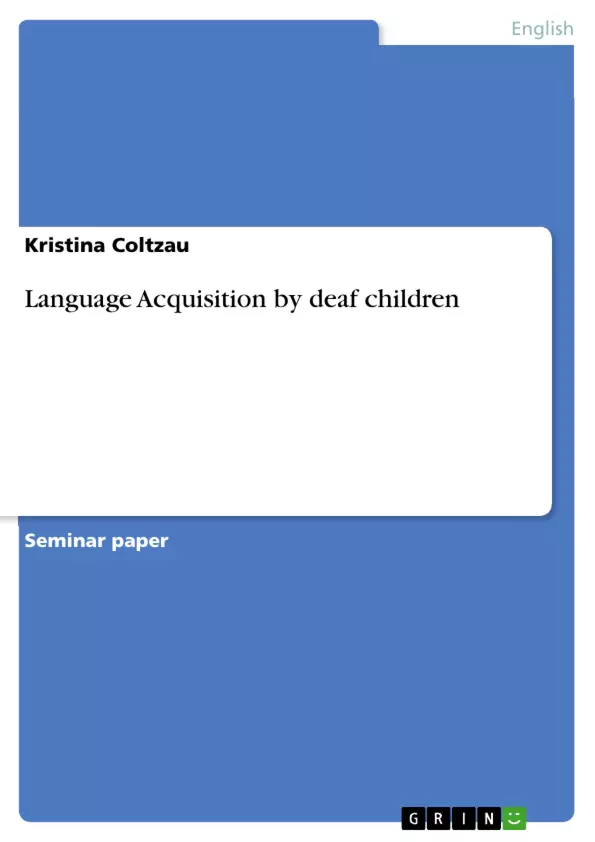Language is the most important device in means of communication between human beings all over the world. We use it to ask something, to complain or explain and to tell what we think about things that come into our mind. But what if everything around you is silent? If you are deaf. You need to take advantage of one of your other organs, the eyes. Take advantage of facial expressions and gesticulation performed by others. In this term paper we have a look on language acquisition by deaf children in comparison with the acquisition by hearing children. First of all I will give information about deafness in general followed by an introduction to sign language. I will concentrate on American Sign Language (ASL) because of the small amount of information available about the other kinds of sign language. Within the comparison we need to differentiate between children growing up with hearing or deaf parents because of the impact the social environment has on language acquisition. This is also relevant to state because only 10% of the deaf children actually have deaf parents. Further I would like to introduce bilingualism in connection with deafness. In my conclusion I will state why studies on the subject of language acquisition by deaf children are important to understand language in his whole complexity.
Inhaltsverzeichnis (Table of Contents)
- Introduction
- Language Acquisition by Deaf Children
- Deafness
- Sign Language
- Language Acquisition by Hearing Children Compared with Deaf Children
- Deaf Children with Deaf Parents
- Deaf Children with Hearing Parents
- Bilingualism by Deaf Children
- Conclusion
Zielsetzung und Themenschwerpunkte (Objectives and Key Themes)
This term paper explores the acquisition of language by deaf children in comparison to hearing children. The paper aims to provide an overview of deafness, sign language, and the specific challenges and opportunities that deaf children face in learning language. The paper also considers the impact of parental hearing status on language acquisition and the role of bilingualism in the lives of deaf children.
- Language Acquisition in Deaf Children
- Deafness and its Impact on Language Development
- Sign Language as a Natural and Complex Language
- The Influence of Parental Hearing Status on Language Acquisition
- Bilingualism and Deafness
Zusammenfassung der Kapitel (Chapter Summaries)
- Introduction: This chapter introduces the topic of language acquisition in deaf children, highlighting the importance of communication and the challenges faced by deaf individuals. It provides context for the paper, emphasizing the differences between hearing and deaf experiences.
- Language Acquisition by Deaf Children: This chapter delves into the specific challenges faced by deaf children in language acquisition. It explores the concept of deafness, its causes, and its impact on social, emotional, and cognitive development. It also introduces the significance of sign language as a natural and complex communication system.
- Deafness: This chapter provides a deeper understanding of deafness, its prevalence, and its potential causes. It discusses the importance of early intervention and screening for hearing loss in infants, emphasizing the role of treatments like speech therapy and sign language in fostering language development.
- Sign Language: This chapter delves into the origins and characteristics of sign language, highlighting its complexity and sophistication as a natural language. It differentiates sign language from signed versions of spoken languages and explores the unique features of sign language, such as its grammatical rules and phonology.
- Language Acquisition by Hearing Children Compared with Deaf Children: This chapter examines the differences in language acquisition between hearing and deaf children. It considers the influence of parental hearing status, discussing the distinct experiences of deaf children raised by deaf parents and those raised by hearing parents.
- Deaf Children with Deaf Parents: This section explores the language acquisition process of deaf children who are raised by deaf parents, highlighting the benefits of exposure to sign language from an early age.
- Deaf Children with Hearing Parents: This section examines the challenges faced by deaf children raised by hearing parents, emphasizing the importance of early intervention and access to appropriate language models.
- Bilingualism by Deaf Children: This chapter explores the concept of bilingualism in the context of deafness. It discusses the benefits and challenges of acquiring both sign language and a spoken language, acknowledging the complexities of language acquisition for deaf children.
Schlüsselwörter (Keywords)
The main keywords and topics of this paper are: language acquisition, deafness, sign language, bilingualism, deaf children, hearing children, parental hearing status, language development, communication, social-emotional development, cognitive development, and early intervention. The paper focuses on understanding the unique challenges and opportunities associated with language acquisition in deaf children and the importance of providing appropriate language models and support.
- Quote paper
- Kristina Coltzau (Author), 2011, Language Acquisition by deaf children, Munich, GRIN Verlag, https://www.grin.com/document/181038



